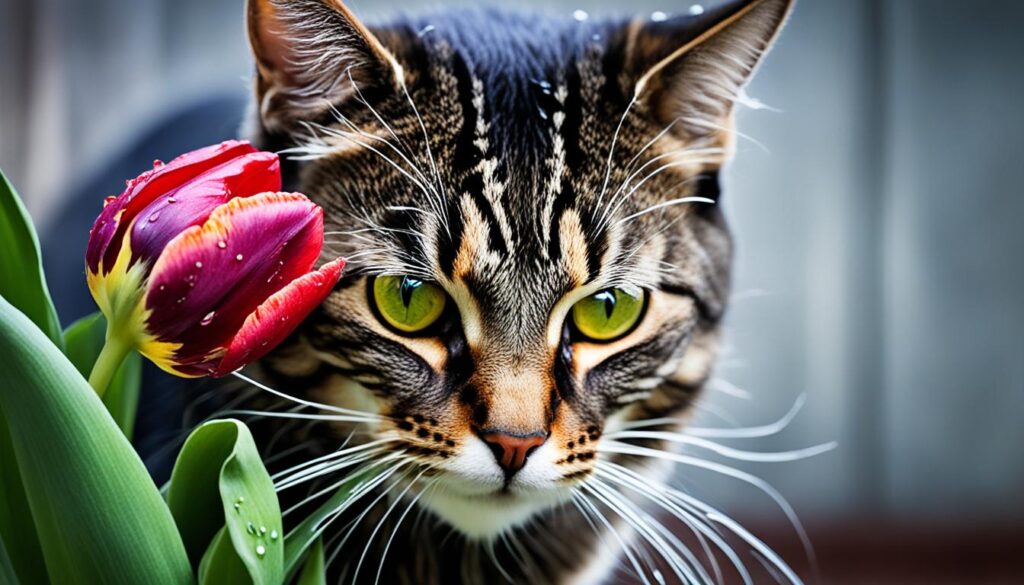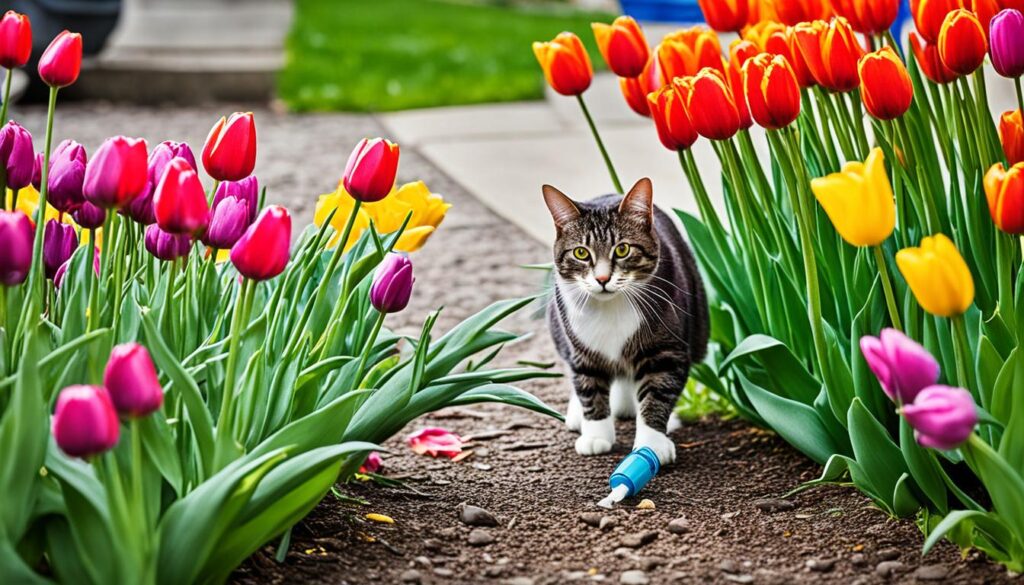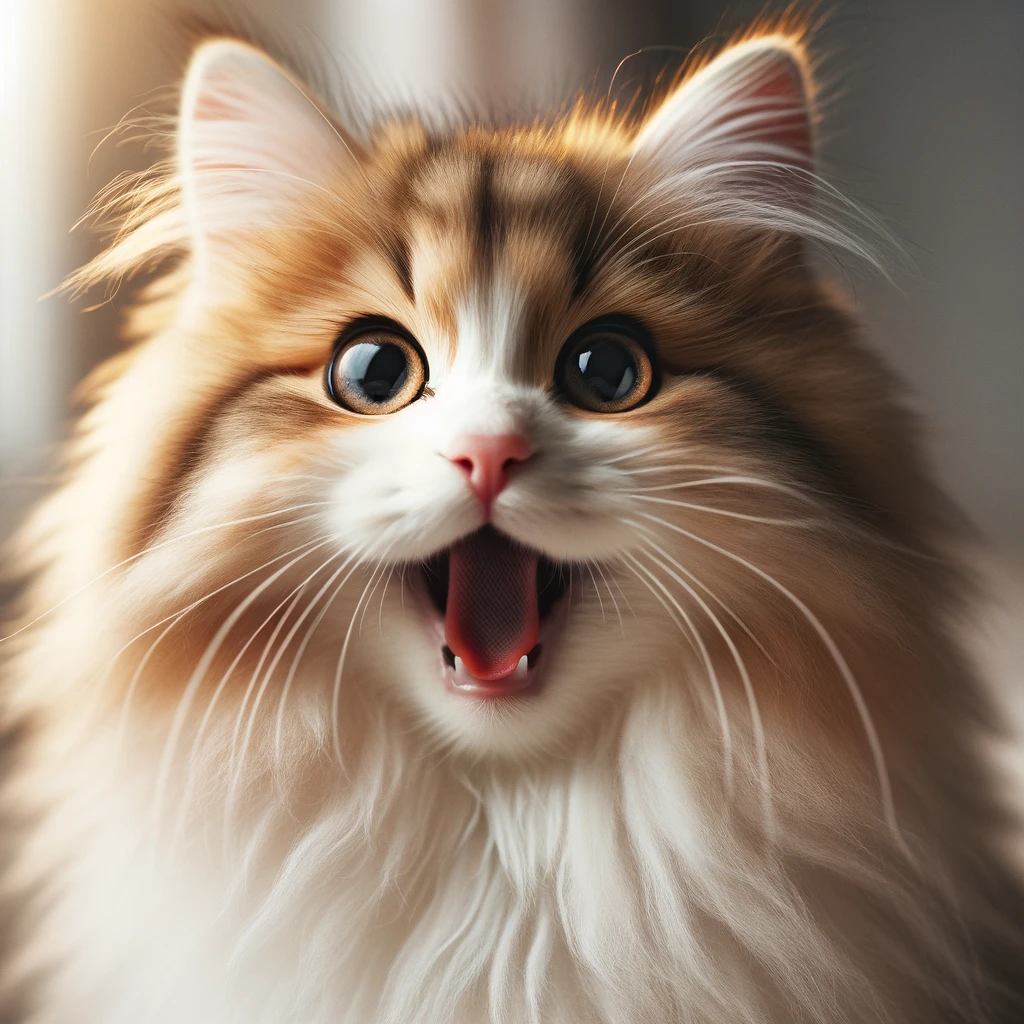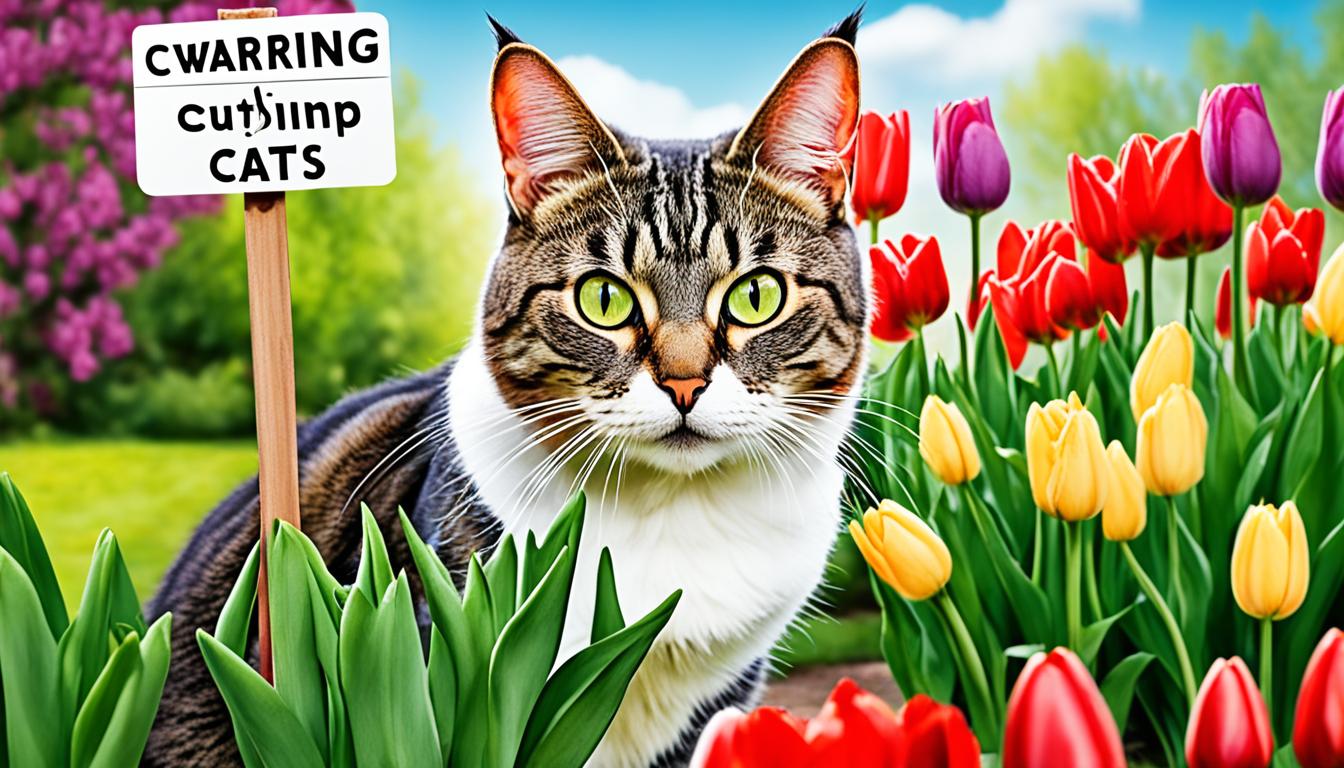As an Amazon Associate I earn from qualifying purchases.
Spring brings beautiful colors, but tulips may be a hazard for cats. These flowers are lovely, but they have toxic compounds. These toxins can be dangerous for our pets if they eat the plants. As a good pet owner, knowing about tulip dangers for cats is important. It helps protect our fur friends during spring.
This guide will teach you about tulip toxicity in felines and how to spot tulip poisoning symptoms. Plus, you’ll learn how to keep your pet away from toxic tulips. Stay educated and take steps to keep your cat safe and happy when the flowers start blooming.
Key Takeaways
- Tulips contain toxic compounds that can be harmful if ingested by cats, particularly concentrated in the bulbs.
- Symptoms of tulip poisoning in cats may include vomiting, diarrhea, drooling, lethargy, and respiratory distress.
- Keeping tulips out of reach and choosing cat-safe tulip varieties or non-toxic tulips are essential for protecting cats from tulips.
- Early recognition of feline tulip ingestion and prompt veterinary care are crucial for successful treatment.
- Exploring cat-friendly tulip alternatives and creating a safe indoor and outdoor environment can prevent tulip hazards for cats.
Introduction to Tulip Toxicity in Cats
Spring is here, bringing bright flowers. But some, like tulips, can be dangerous for our cats. These flowers have toxic compounds, mainly in their bulbs. Since cats like to explore and may chew on plants, they can get sick from tulip poisoning.
Common Spring Flowers and Their Potential Dangers
Lilies, daffodils, tulips, hyacinths, and azaleas are risky for cats. They contain toxins that are dangerous if cats eat them.
Why Tulips Can Pose a Risk to Feline Companions
Tulips and hyacinths are known to have allergenic substances that can harm cats. The dangerous parts are mainly the bulbs. If a cat eats these bulbs, they might suffer from severe poisoning.
Eating tulips can cause mouth and throat irritation. Symptoms of tulip poisoning in cats include lots of drooling, throwing up, and diarrhea. Big amounts can cause more serious issues, like heart or breathing problems.
Tulips have toxic alkaloids, tulipalin A and B. These can make cats very sick. Symptoms of tulip toxicity in felines vary from stomach trouble to severe health issues.
It’s important to avoid letting cats near tulips>. If a cat might have eaten some and shows signs of poisoning, get them to a vet right away.
Understanding the Toxicity of Tulips
Tulips might look pretty, but they pose a danger to cats. Tulip toxicity in felines is a real threat. Every part of the tulip plant can harm cats if eaten.
Toxic Components Found in Tulips
Allergenic lactones are the dangerous substances in tulips. These are mostly in the bulbs. Feline tulip ingestion is risky. The leaves and flowers also have these toxins, but in less amount.

When cats eat tulips, they might get sick. These allergenic lactones can cause tummy troubles, drooling, and more. Tulip poisoning cats is serious and has bad effects.
Symptoms of Tulip Poisoning in Cats
Tulip toxicity in felines has different effects based on how much and which part of the plant they eat. Mild cases cause sick stomach signs. Big amounts, especially the bulbs, can be very harmful. This includes:
- Bloody diarrhea
- Weakness and lethargy
- Seizures
- Difficulty breathing
Most cats don’t eat a lot of plants. But, some may and put themselves in danger of tulip poisoning and its serious effects.
| Symptom | Mild Ingestion | Severe Ingestion |
|---|---|---|
| Vomiting | ✓ | ✓ |
| Diarrhea | ✓ | ✓ (potentially bloody) |
| Drooling | ✓ | ✓ |
| Weakness | ✓ | |
| Seizures | ✓ | |
| Breathing Difficulties | ✓ |
If your cat eats any part of a tulip, act fast. Getting them checked by a vet is crucial. Protecting cats from tulips is the top safety measure for your pet.
Are Tulips Toxic to Cats?
Tulips are loved for their vivid colors and soft petals by many. However, they can be dangerous to our feline friends. These flowers have harmful parts that hurt cats who eat them. Knowing about tulip toxicity is key to keeping your cat safe.
Tulip Bulbs: The Primary Source of Toxicity
Tulip bulbs are very risky for pets, with dangerous chemicals. If a cat eats part of a toxic bulb, it might get very sick or worse. The worst cases of tulip poisoning in cats come from eating the bulbs.
Toxic Effects of Ingesting Tulip Leaves and Stems
Leaves and stems of tulips are also dangerous. Eating these can irritate a cat’s mouth or throat. It might cause symptoms like throwing up, diarrhea, and a lot of drooling. Keep tulip plants away to protect your pal.
| Symptoms | Treatments |
|---|---|
| Vomiting | Inducing vomiting (within 4 hours of ingestion) |
| Diarrhea | Administering activated charcoal |
| Drooling | Gastric lavage (in severe cases) |
| Abdominal pain | Supportive care |
| Tremors | Monitoring and treatment of complications |
| Coma | Fluid therapy |
Keep your cat safe by not having tulips where they can reach. And if you think they’ve eaten some, see a vet fast. Being careful lets you love tulips without worrying about your cat’s health.
Protecting Your Cat from Tulip Hazards
As a cat owner, keeping your pet safe from tulips is key. These flowers are pretty but dangerous if eaten by cats.
Keeping Tulips Out of Reach
To keep your cat safe, don’t let them near tulips. It’s best not to plant these flowers or have them inside. If you do, put them where your cat can’t get to them.

Alternatives to Tulips for Cat-Friendly Homes
Love tulips’ look but worried about your cat? You can pick other safe flowers. Try roses, sunflowers, orchids, and zinnias. These flowers are pretty and won’t harm your cat.
Choosing the right flowers keeps your cat safe and your home beautiful.
| Toxic Plants | Symptoms in Cats | Cat-Safe Alternatives |
|---|---|---|
| Tulips | Vomiting, diarrhea, drooling, lethargy, abdominal pain | Roses, sunflowers, orchids, zinnias |
| Lilies | Kidney failure, vomiting, lethargy | African violets, spider plants, Boston ferns |
| Azaleas | Vomiting, diarrhea, excessive drooling | Bromeliads, catnip, cat grass, Boston ferns |
Be smart and pick safe plants so you and your cat can enjoy spring safely.
Tulip Toxicity Levels in Cats
Tulips are very dangerous for cats. The tulip toxicity in felines depends on what part they eat and how much. Bulbs are the worst and can cause dangerous tulip poisoning in cats.
Just tasting a bulb can be extremely harmful. They have a lot of bad stuff in them. This makes bulbs the most dangerous part of toxic tulips for cats.
Eating the leaves, stems, or flowers is a bit less harmful. But, any amount of tulip eaten is bad news. It must be treated as a poisoning case to keep your cat safe.
Tulip toxicity symptoms in cats can be mild or severe. Mild cases may include throwing up or diarrhea. But, it can get bad with seizures or trouble breathing. This shows why fast vet help is so important.
All parts of the tulip plant are poisonous to cats, with the bulb containing the highest concentration of toxins.
To sum up, tulip toxicity levels in felines are serious:
- Ingesting tulip bulbs can be deadly
- Eating leaves, stems, or flowers can cause less serious issues but is still dangerous
- Symptoms may include stomach problems, seizures, and trouble breathing
- Quick vet care is very important if you think your cat has eaten a tulip
| Plant Part | Toxicity Level | Potential Symptoms |
|---|---|---|
| Bulbs | Highly toxic | Severe gastrointestinal distress, neurological effects, respiratory failure, cardiac issues |
| Leaves, stems, flowers | Moderately toxic | Vomiting, diarrhea, drooling, lethargy |
Good pet owners keep their cats away from tulips. They quickly get vet help if their cat eats any.
First Aid for Tulip Poisoning in Felines
Tulips are beautiful but can harm our cats. If you think your cat ate a tulip, act fast. It’s important to know the signs of tulip poisoning. Doing so means your cat can get help quickly, which makes recovery more likely.
Recognizing Signs of Tulip Ingestion
The first step to help with tulip poisoning in cats is to know the signs. Look for symptoms like vomiting, diarrhea, and drooling. Also, keep an eye out for tiredness, not eating, and stomach pain. These signs can mean your cat ate something bad. You need to act without delay.
Seeking Veterinary Assistance
If you see signs of tulip poisoning in cats, getting vet help is a must. Fast care reduces the chance of big problems and boosts recovery odds. When at the vet, tell them everything you know. What type of plant, how much, and when it happened. This helps them figure out the best treatment.
To keep your cat safe from tulips, be watchful. Enjoying spring’s beauty is okay if you’re careful. Preventing tulips from harming your cat is important. Yet, if there’s a problem, quick action and expert help can save the day. Stay alert and keep your cat out of harm’s way.
Non-Toxic Tulip Varieties for Cat Owners
Most tulip types are not safe for cats because they are toxic. But, a few non-toxic tulips for cats exist. These are good for people who like tulips and care about their pet’s health.
Exploring Safe Tulip Options
Some tulips, like Tulipa clusiana and Tulipa saxatilis, are less harmful or safe for cats. Yet, it’s vital to check and talk to an expert before you plant any tulips if you have cats. Always be careful, even with safe types, and watch how your cat acts around them.
Creating a Cat-Friendly Garden
For garden lovers wanting tulips, think about a cat-friendly spot. Use fences to keep cats away or choose non-toxic, cat-safe tulips. This makes sure there’s little danger if they are eaten by accident.

Following these steps lets you have lovely tulips and keeps your cats safe. The goal is to prevent any issues. Making a special spot or picking cat-friendly tulip varieties supports a happy coexistence, especially when flowers bloom.
Feline-Safe Alternatives to Tulips
Tulips are beautiful but harmful to cats. For cat owners, it’s crucial to find alternatives. Look for non-toxic tulips for cats to keep your furry friends safe. Some safe options can still bring spring’s beauty to your life.
Choosing Non-Toxic Flowering Plants
There are many cat-friendly tulip varieties that won’t harm your pets. Consider plants like roses, sunflowers, African violets, orchids, and zinnias for color and fragrance.
These alternatives can make your spaces look vibrant. They let you enjoy spring while protecting your cat from dangers of tulip hazards for cats.
Creating a Pet-Friendly Indoor Environment
To enjoy spring inside, choose plants that are safe for your cat. Pick from cat-safe tulips list, including roses, sunflowers, and orchids. Place them where your cat can’t reach.
Use vases and containers that are also safe for pets. This further prevents harm from toxic substances. It keeps your cat curious yet safe around flowers.
Remember, prevention is key for protecting cats from tulips and other toxic plants. Opt for feline-friendly options to enjoy spring worry-free with your pet.
Educating Others About Tulip Toxicity in Cats
Being a good pet owner means you can help spread the word about tulip toxicity in felines. Sharing what you know can stop tulip poisoning cats. It makes the area safer for cats in your community.
Raising Awareness in the Community
Talk to your friends and family about toxic tulips for cats. Make sure people who own cats or plan to buy tulips know the risks. This helps keep cats safe and avoids accidental poisonings.
Think about telling people at local places like community centers or libraries. Offer to talk, hand out flyers, or have a booth. Your efforts could save many cats by sharing important safety info about tulips.
Sharing Information with Fellow Pet Owners
Make friends with other pet owners in your area. This could be through pet clubs or online groups. Tell them about the dangers of tulips for cats. Encourage them to use safe plants instead and show them where to find more info on pet-safe gardening.
Starting an online group could be a great idea. This group could be all about teaching others about tulip toxicity in cats. Ask pet owners to share what they do to keep their pets safe during the blossom season.
| Tulip Toxicity in Cats | Symptoms | Prevention |
|---|---|---|
| Tulips contain alkaloids like tulipalin A and B, which can be harmful if ingested by cats. | Gastrointestinal upset, difficulty breathing, increased heart rate, organ damage in rare cases. | Keeping tulips out of reach, choosing cat-friendly alternatives like spider plants, Boston ferns, and catnip. |
| All parts of the tulip plant are toxic to cats, with the bulbs being the most dangerous. | Vomiting, diarrhea, drooling, lethargy, abdominal pain. | Seeking immediate veterinary attention if tulip ingestion is suspected for a better outcome. |
By telling others, you promote a safer environment for cats. Learning about tulip toxicity in felines can save many lives in your area.
Tulip Poisoning Prevention Tips for Cat Owners
Keep your cat away from tulip hazards by knowing where they are. Tulip bulbs are toxic to cats, with harmful compounds like alkaloids and allergenic lactones. Check your garden, bouquets, and houseplants for these toxic tulips. Remove them or keep them away from your cat.
Identifying Potential Hazards
It’s important to spot signs that your cat might eat tulips. Look for any tulip parts that seem chewed on. Remember, even a little bit could be bad for your cat. Make sure you dispose of any tulip leftovers safely, too.
Creating a Safe Home Environment
Choose non-toxic tulips or safe flowers like roses, sunflowers, or orchids. If you really want tulips, put them where your cat can’t reach. Give your cat lots of toys and fun areas to play. This helps keep them from being interested in the plants.
Stopping a problem before it starts is crucial in guarding your cat from tulips. Take steps like removing dangers and making your home safe. This way, you and your cat can enjoy spring without worry.
| Toxic Plant | Potential Effects | Prevention |
|---|---|---|
| Tulips | Vomiting, diarrhea, drooling, depression, abdominal pain, tremors, increased heart rate, convulsions, respiratory issues, cardiac arrhythmias, coma, and mouth/throat irritation | Remove tulips from home and garden, opt for cat-friendly tulip varieties, or choose non-toxic alternatives |
| Lilies | Kidney failure, vomiting, lethargy, loss of appetite | Avoid bringing lilies into the home, ensure outdoor areas are free from lilies |
By keeping to these tulip poisoning prevention tips, you make a safe space for your cat. This ensures both you and your pet can enjoy spring safely and together.
Conclusion
As we wrap up our talk on are tulips toxic to cats, we see a big risk. These pretty flowers can be harmful. Tulips have a toxin called tulipalin A and B. These can cause major health problems in cats.
This can include throwing up, diarrhea, or trouble breathing. It can even harm their organs. The most toxins are in the bulbs, which are very dangerous if eaten.
Although tulips are beautiful, your cat’s safety comes first. It’s key to avoid tulip poisoning and keep our pets safe. To do this, keep tulips away, make sure indoor plants are safe, and pick non-toxic tulips.
If you think your cat ate a tulip, act fast. Clean their mouth, give them water, and call the vet right away. Getting help early can save their life.
Always make sure cats can’t get to tulips. Also, teach others the dangers of tulips for cats. This way, we help our pets stay safe and happy.
FAQ
Are tulips toxic to cats?
Which part of the tulip is most toxic to cats?
What symptoms might a cat exhibit after ingesting tulips?
Are there any non-toxic tulip varieties for cat owners?
What should I do if I suspect my cat has ingested tulips?
How can I protect my cat from tulip hazards?
Are there any safe alternatives to tulips for cat-friendly homes?
As an Amazon Associate I earn from qualifying purchases.

